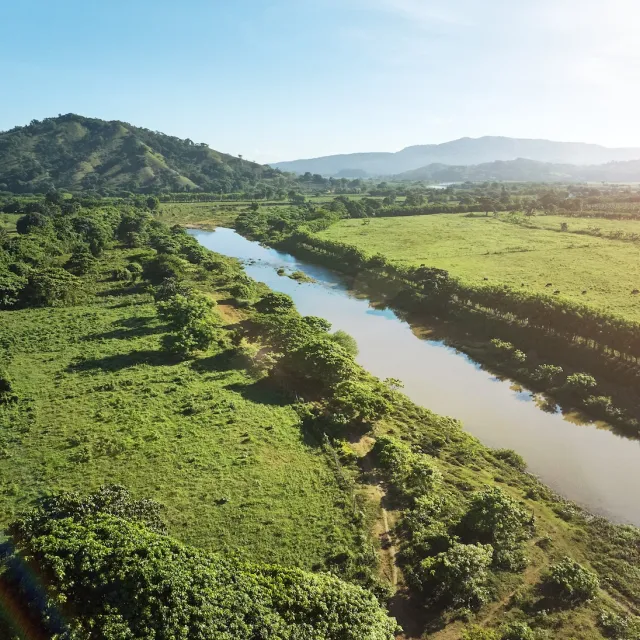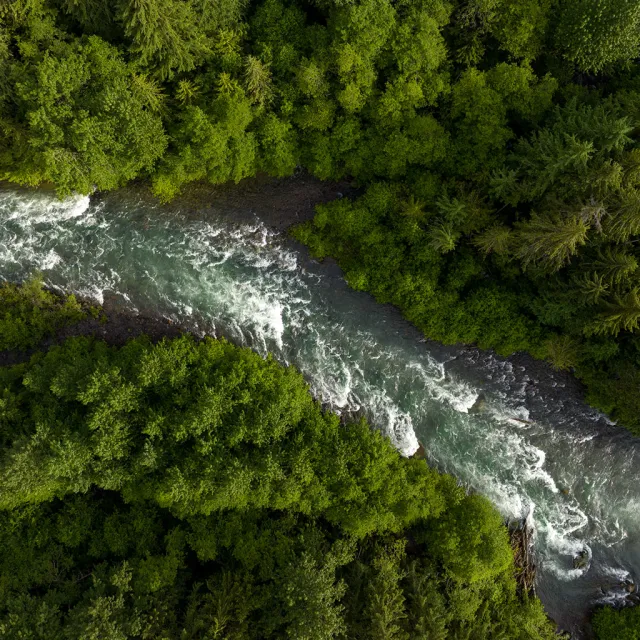
As corporate sustainability professionals face increasing pressure to address water-related risks, nature-based solutions are emerging as powerful opportunities in the water stewardship toolkit.
Trees offer compelling benefits that align with corporate sustainability goals and can showcase your brand is serious about environmental responsibility. However, implementing water stewardship initiatives require thoughtful planning, strong partnerships, and measurable outcomes particularly when engaging in tree planting. Drawing on the experience and insights from expert practitioners, this article outlines five essential considerations for corporate sustainability leaders looking to leverage trees as part of their water stewardship strategy.
1. Recognize Your Company's Dependency on Healthy Watersheds and Forests
Many companies undervalue water, often treating it as a limitless resource coming into their building or factory, however there may be a bigger responsibility to consider. For years, those focused on watersheds and water stewardship have encouraged corporations to think beyond their four walls—and this chorus is gaining momentum. There is a growing movement to better recognize where water comes from and its materiality on core business resilience—and for many leading corporates that connection often ties back to the forested headwaters where water might begin its journey to our pipes.
Approximately 180 million Americans (roughly 56% of the U.S. population) get their drinking water from forested watersheds, as estimated by the U.S. Forest Service1.
"Many of our watersheds begin in forested landscapes—that’s where some of the cleanest, most pristine water comes from.” notes Jon Radtke, Senior Director of Corporate Water Stewardship at Bluerisk. “Healthy forests are vital to sustaining these water sources and we often don’t realize how much we depend on them." Understanding this dependency is the first step toward meaningful water stewardship.
According to Environment America policy network, “150 million people in the United States have some of their drinking water filtered by forests2”. This is a huge dependency that can be addressed through the power of trees.
Healthy forests filter water, regulate water flow, reduce flooding, and maintain water quality—all ecosystem services that businesses depend on but often undervalue. When sustainability professionals begin to recognize these dependencies, they can expand their focus from internal measures to protecting and restoring forests and trees that ensure clean, reliable water.
2. Leverage Trees to Address Multiple Corporate Sustainability Priorities
Unlike "gray infrastructure" investments that typically serve a single purpose, trees and forests deliver a range of ecosystem services. When planting, managing, and protecting forests, they almost always will clean water, sequester carbon, create habitat and benefit people. As corporate sustainability goals become less siloed, and more multi-faceted, interventions that use trees may deliver more value per dollar invested.
Beyond the quantifiable co-benefits, trees offer a narrative-rich approach that resonates deeply with customers and other stakeholders. Trees and their value are inherently understood by people spanning economic status, political affiliation, and even geography. Trees serve as a powerful bridge between the quantifiable elements and the emotional, inspirational components, helping companies connect their sustainability strategies with their customer base.
This multi-benefit approach is particularly valuable for companies whose sustainability programs integrate water stewardship within broader nature or climate initiatives. By strategically selecting projects that address water challenges through reforestation or forest conservation, companies can check multiple boxes with a single investment—making the business case stronger than for single-focus solutions.
There are numerous ongoing efforts to further guide the accounting of multiple benefits within the watershed context. Most notably the Pacific Institute and the CEO Water Mandate have released a Biodiversity Benefit Accounting Landscape Assessment and an emerging guidance document on identifying and accounting for nature-based benefits.
3. Understand the Context and Select the Right Intervention for the Challenge
While trees offer numerous benefits, they may or may not be the right solution for your water stewardship challenge. Context matters, and sustainability professionals must start with a clear understanding of the specific water challenges they're trying to address.
"First you need to look at the issues in the watershed—what are those shared water challenges? Those are what you should be focusing on to address," advises Radtke. "You don't want to force a square peg into a round hole. Start with the problem."
This problem-first approach is reflected in leading water stewardship frameworks. The Volumetric Water Benefit Accounting (VWBA) guidance begins with identifying shared water challenges before determining which interventions are appropriate. The most effective water stewardship programs examine the landscape context, water risks, and stakeholder needs before deciding whether trees are the right solution.
For example, in watersheds facing water quality issues from agricultural runoff, riparian buffers might be ideal. In areas with soil erosion and flooding, strategic reforestation in a headwater could be most effective. In contrast, in water-scarce regions, certain types of afforestation might reduce water availability through increased evapotranspiration—a nuance that needs careful consideration, or a forested headwater might simply be too indirectly relevant to be considered the highest priority project within a specific basin or water-related business risk.
"Oftentimes there are multiple shared water challenges in a given watershed and it’s important to identify the right interventions to address the various issues." explains Ben Wilinsky, Director of Partnerships and Innovation at the Arbor Day Foundation, emphasizing the importance of selecting interventions that address specific issues and not the other way around.
4. Select Partners with Experience and Integrity
Using trees in water stewardship initiatives requires specialized expertise and long-term commitment. Unlike built infrastructure that you can control directly, trees and forests are living systems subject to numerous challenges. Choosing the right partners can help corporate navigate the water stewardship space and ensure that proposed solutions align authentically to challenges.
An ideal partner in tree-forward solutions brings both technical expertise in forestry and watershed context, and an understanding of corporate needs and expectations. They should have a track record of delivering successful projects, transparent measurement approaches, and the integrity to provide honest guidance—sometimes even recommending against planting trees when it's an inappropriate, or less material, solution.
"Planting the right trees in the right places at the right time for the right reasons - that's what drives lasting impact," said Wilinsky. "To do that well, you need experienced, trusted, local partners. They are best equipped to drive decisions around ecological context and community needs. Our global network of shovel-ready partners allows us to collaborate with those who deliver these meaningful results and often our role is to translate these needs into the corporate context." There is often a critical phase to bridge ecological requirements and corporate expectations.
Moreover, Radtke emphasizes that the relationship should go beyond transactional measurements: "I’d like to think of them as a real partner that will keep you informed and engaged throughout the process, including actually seeing what you've supported on the ground. Experiencing it, seeing the impact it has on the community, or the ecosystem is so important. The right partner should make it more than just a number on a spreadsheet."
5. Build Risk Awareness and Transparency into Your Approach
Tree-based solutions involve inherent risks that need to be acknowledged and managed—from forest fires and invasive species to impacts on climate and evolving policy environments. Successful water stewardship relies on transparency and strategic planning to mitigate risks.
"This isn't drip irrigation that you go and install, put down the infrastructure and walk away," explains Paul Reig, founder and CEO at Bluerisk, highlighting that tree-based solutions "require a certain amount of sophistication to do well with the right species."
Being aware of and transparent about these risks is essential—both for internal decision-making and external communication. This includes recognizing challenges like the time lag between planting and accumulated water benefits, the potential for ongoing natural disturbances, and the complexities of monitoring and verification.
The Arbor Day Foundation's approach emphasizes this transparency: "Our intention is to lower risk, not raise it," notes Wilinsky. This includes documenting recommendations, clearly communicating the timeframe for benefits, recognizing when tree-based approaches might not be right for the job, and providing dynamic reporting throughout the project horizon.
One way corporates manage this risk is by diversifying their portfolio of projects to include other types of mitigation strategies within a watershed - i.e., agriculture bmps, demand reduction, etc. Post-project monitoring and verification will typically involve a yearly site reconnaissance (on the ground or via remote sensing) to track tree survival rates and tree growth to ensure post-project modeled conditions are met. The water benefits from a reforestation project can be counted all at once right after planting, phased in gradually as the trees grow, or the volumetric benefit can be reduced by a factor to reflect that the full benefits won’t happen right away.

Where We Go from Here
Nature-based solutions will continue to be a key ingredient in robust water stewardship strategies. When corporations understand the nuances of water stewardship and apply these things to their business, they are not only doing good by their stakeholders and customers but also having a positive impact on the planet.
At the Arbor Day Foundation, we believe that trees have the power to do profound good for people and the planet. Trees provide strong benefits regarding water stewardship and we are proud to work alongside corporates as they navigate the water stewardship puzzle and work to incorporate the right components to create a winning strategy.
If you are interested in speaking about how trees can fit into your water stewardship strategies and goals, let’s talk.
References:
-
Source: U.S. Forest Service, “Forests to Faucets” (2010)
Ready to talk water? Let’s talk trees.
Wherever you are on your water stewardship journey, join us to explore how trees could be a nature-based option that’s good for business and our collective future.